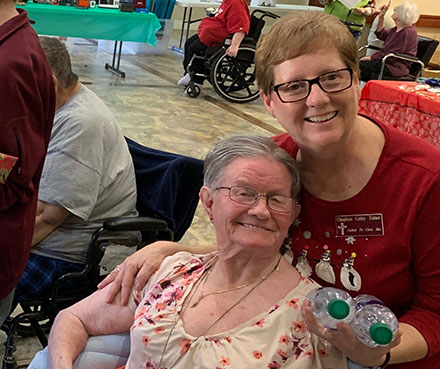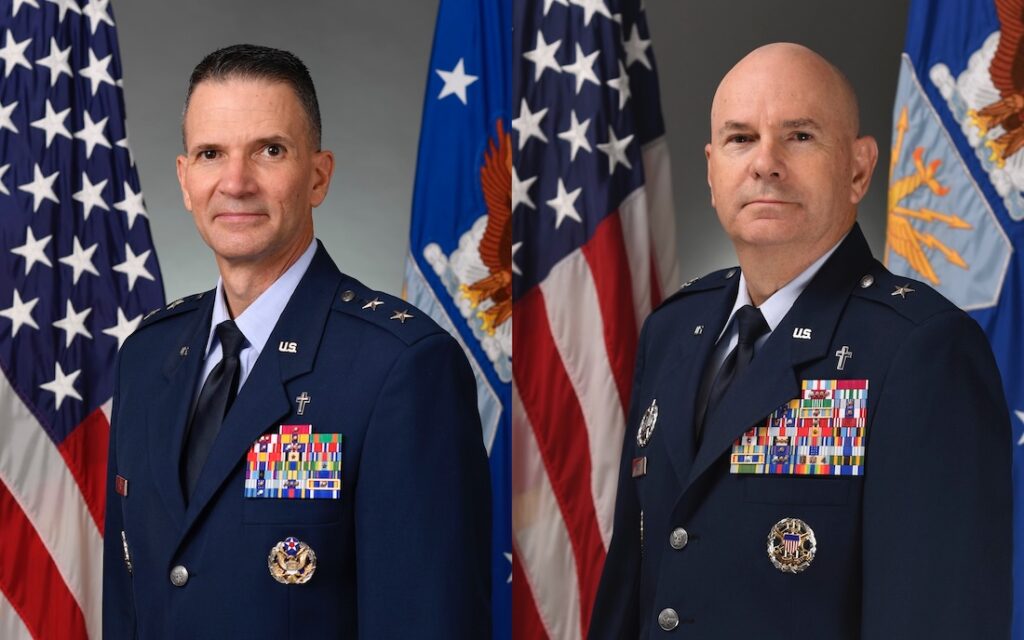By Brandon Elrod
OKLAHOMA CITY, Okla.—One of the most difficult things for Cathy Tisher, a chaplain to three different nursing homes in the Oklahoma City area, is seeing the face of a particular nursing home resident as she conducts regular video calls.
Tisher knows something that he does not. Roughly three weeks after visitors were prohibited from entering the facility due to the coronavirus pandemic, this resident’s wife passed away.
“The situation is breaking my heart,” Tisher said. “In March, his wife was no longer able to go in, and she had been one of the most faithful to come and see him. She would come every day.”
The family wrestled with the decision of whether or not to tell him. They want to share with him in person, but in order to do so, they would have to go in, relay the news and afterward leave almost immediately.
“They haven’t told him because they don’t want him to have to be alone after receiving that news,” Tisher said. They worry it will be too much for him to bear.
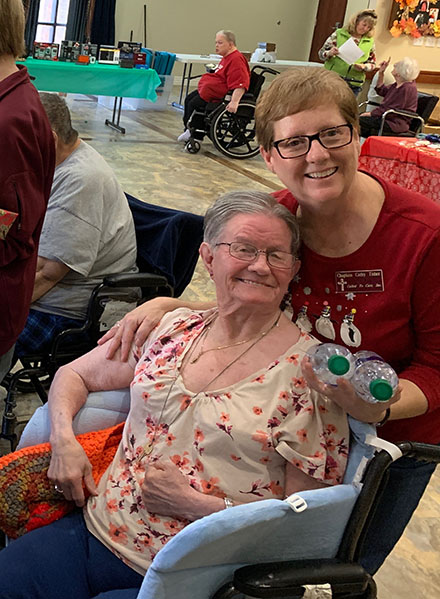 Cathy Tisher, a Southern Baptist chaplain to three different nursing homes in Oklahoma City, with a resident before the COVID-19 pandemic. Since around March, the facilities Tisher serves have only been allowing employees into their buildings. Tisher has utilized Skype and other digital means to continue ministering to residents, their families and to nursing home staff. Photo submitted by Cathy Tisher.
Cathy Tisher, a Southern Baptist chaplain to three different nursing homes in Oklahoma City, with a resident before the COVID-19 pandemic. Since around March, the facilities Tisher serves have only been allowing employees into their buildings. Tisher has utilized Skype and other digital means to continue ministering to residents, their families and to nursing home staff. Photo submitted by Cathy Tisher.
Across North America, Southern Baptist chaplains are walking through heart-wrenching ministry situations like this with nursing home residents, their families and the staff. The susceptibility of the elderly to COVID-19 has affected those who seek to serve the nursing home population.
According to a USA TODAY report, at least 2,300 long-term care facilities in 37 states have reported positive cases of COVID-19, and at least 3,000 residents have passed away.
“In Oklahoma, they have told us that 40 percent of the COVID-19 deaths that we have are in nursing homes,” said Tisher, a member of Southern Hills Baptist Church in Oklahoma City.
While the facilities Tisher serves continue to allow only employees inside, she has been conducting Bible studies each week via Skype. The staff set up laptops either in the activity rooms or in individual rooms, and she is able to teach through a video chat, though she cannot interact as she teaches the way that she would like.
“It has been really tough. It’s been hard to be at a distance like this,” Tisher said. “I’m being told it will be at least July and maybe even August before they open back up to the public.”
The facilities have allowed “drive by’s” where family can stop by to see residents briefly and interact from the outside of the building through closed windows. Residents also participated in a “parade” where they made their way through the parking lot as friends and family cheered them on from a distance.
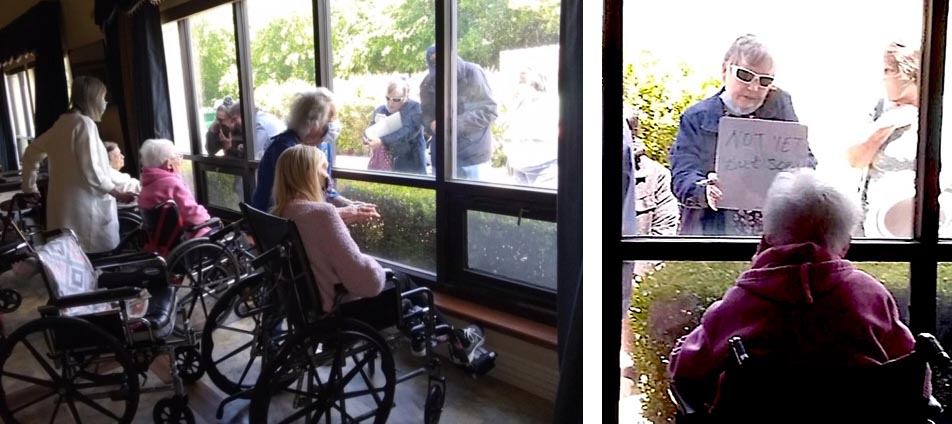
At the nursing home facilities that Southern Baptist chaplain Cathy Tisher serves, family members of residents have only been able to visit by looking in through closed windows from outside the building. One visitor wrote “not yet, but soon” on a dry-erase board.Photo submitted by Cathy Tisher.
Accessibility to nursing facilities varies from region to region. In Missouri, chaplain Mike Crowell, a chaplain and chaplain ambassador with the North American Mission Board, has been able to enter The Gardens Assisted Living and Memory Care in Kansas City where he serves and continues conducting weekly worship services and Bible studies.
“Each time I come in, they do a temperature check and ask me how I’m doing,” said Crowell, a member of Pleasant Valley Baptist Church in Liberty, Mo. “I also wear a mask when I come in and lead services. It is different. It gives you an appreciation for those who do that all the time.”
He maintains proper social distancing and does not physically interact with residents and those in memory care. In one instance, his temperature was slightly above normal, and out of respect for the staff and residents, Crowell did not go in that day.
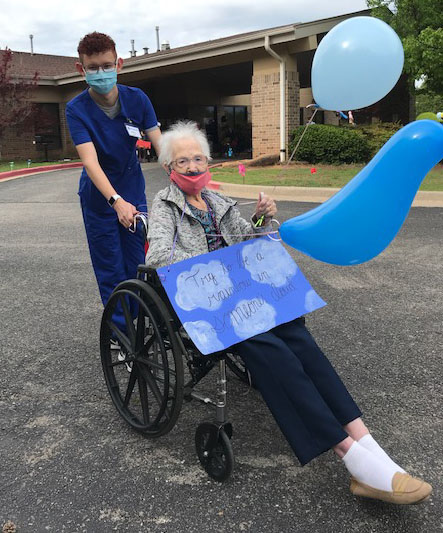 Residents of a nursing home in Oklahoma City participated in a “parade” as friends and family waved and cheered them on from a distance. Cathy Tisher, a Southern Baptist chaplain, typically serves the nursing home community but has had to resort to using video chats and other digital means to continue ministering to residents, their families and the staff. Photo submitted by Cathy Tisher.
Residents of a nursing home in Oklahoma City participated in a “parade” as friends and family waved and cheered them on from a distance. Cathy Tisher, a Southern Baptist chaplain, typically serves the nursing home community but has had to resort to using video chats and other digital means to continue ministering to residents, their families and the staff. Photo submitted by Cathy Tisher.
While the family members cannot, in most instances, do anything besides walk up to the windows from the outside of the building, one exception provided a moment of encouragement to Crowell.
The daughter of one of the memory care patients at his facility was able to be with her father as he passed away. Earlier, she had shared with Crowell that her father had been struggling with certainty over his spiritual condition.
Crowell shared a covenant statement with her about committing to follow Christ, and her father, who was 98 or 99 years of age, initialed the statements of commitment, and he displayed them in a place where he could look and remember them any time he wavered.
“He died the day after Resurrection Sunday,” Crowell said. “His daughter was given special permission to come in and visit while her dad was dying.”
As these examples illustrate, the COVID-19 pandemic has made ministry difficult but not impossible, and chaplains encourage Christians and churches to find ways to minister to the elderly during this time.
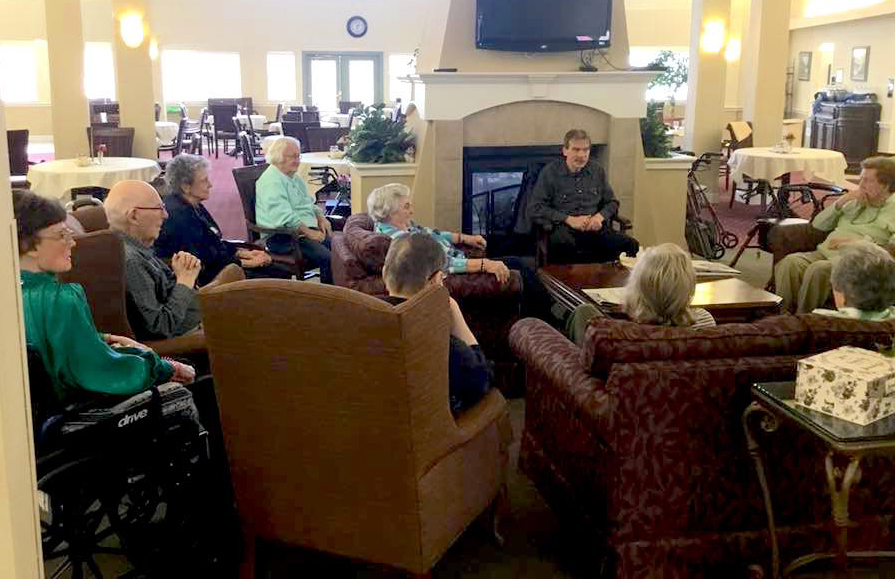 Mike Crowell, a Southern Baptist chaplain, regularly visited residents of The Gardens Assisted Living and Memory Care in Kansas City, as in this 2018 photo, before the COVID-19 pandemic broke out. Crowell has still been able to visit the facility, following precautions such as having his temperature taken before entering, wearing a mask and actively social distancing. Photo from The Gardens Facebook page.
Mike Crowell, a Southern Baptist chaplain, regularly visited residents of The Gardens Assisted Living and Memory Care in Kansas City, as in this 2018 photo, before the COVID-19 pandemic broke out. Crowell has still been able to visit the facility, following precautions such as having his temperature taken before entering, wearing a mask and actively social distancing. Photo from The Gardens Facebook page.
“It has always been my prayer that churches would adopt a facility in their neighborhood even under normal circumstances,” said Tisher.
Philip Peavey, a chaplain at the University Medical Center in New Orleans, served nursing home residents and staff for 30 years as both a pastor and a chaplain before becoming a chaplain at the medical center.
“The key was going to the activities director in the nursing homes, and that was my point of entry for getting into nursing homes,” said Peavey, now a member at First Baptist New Orleans. “When I did that ministry, I would check on the staff and do visitation with the patients.”
Social distancing requires that most communication take place via text messages, phone calls and email, but communicating with the facilities in the community may reveal specific needs that residents or staff may have.
“Begin by talking to the director and saying, ‘we are interested,’” said Crowell. “Ask, ‘How may we serve you?’ and ‘How may we serve the residents?’ Then be ready to have some suggestions in case the director doesn’t have any ideas or asks what you can offer.”
Provide resources, meals, thank you cards or gift cards, to the staff to let them know they are appreciated. Ask members of your congregation who have family in assisted living homes if they have ideas they can share.
“Any way a church can reach out, I would say do it,” said Tisher.
Brandon Elrod writes for the North American Mission Board.
Published May 12, 2020
